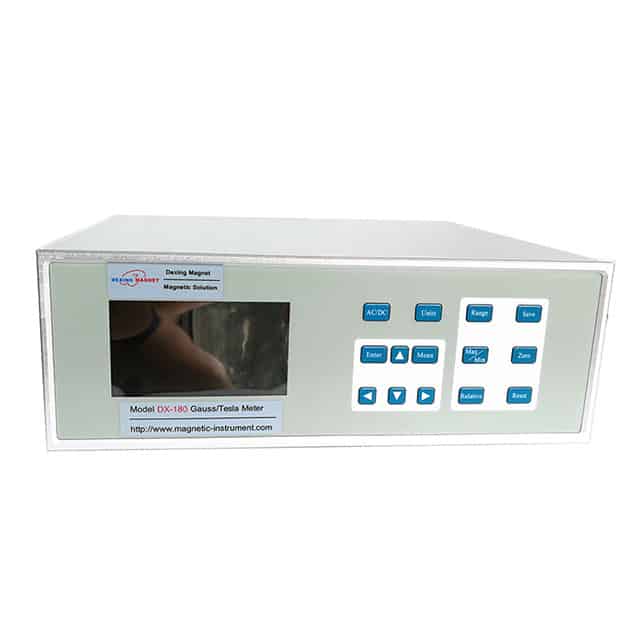products categories
contact us
- If you have questions, please contact us, all questions will be answered
- Tel : 18030236818
- Fax : +86-592 5237901
- Email : dexing@china-dexing.com
Hall Effect Measurement System
Fundamentals of magnetic measurement
1 Magnetic induction intensity is a physical quantity used to describe the property of magnetic field, which is represented by B. The direction of B at a certain point in the magnetic field is the direction of the magnetic field at that point, and the magnitude of B represents the strength of the magnetic field at that point.
In the SI system of units (the International System of Units), the unit of magnetic induction is [volt · second/meter 2], and [volt]·[second] is called Weber, so the unit of magnetic induction is called [Weber/meter 2] or [tesla], short for [t]. In the CGSM system of units, the unit of magnetic induction is [gauss]. The units are expressed in symbols: V is [volt], S is [second], M is [metre], WB is [weber], T is [T], GS is [gauss], MT is [milt].
1T=1Wb/m2=104Gs=103mT (1)
2. Magnetic field lines, magnetic flux and magnetic flux continuity theorem
We use magnetic field lines to visualize the magnetic field. The magnetic field lines of various magnetic fields generated by the current are shown in Figure 1. Magnetic field lines are closed lines with no end and no tail around the current, and the direction of the current and the carriage return direction of the magnetic field line conform to the right-hand rule.
Using the law of ampere loop, we can easily calculate the magnetic field generated by the current with certain spatial symmetry. For example, calculate the magnetic field strength at point P inside a uniformly densely wound toroidal solenoid, as shown in Fig. 4. I take a closed integral curve, concentric circles of radius r, through point P. Due to the symmetry relation, the magnetic field intensity of each point on the periphery of the concentric circle is equal, and the direction of magnetic field intensity is along the tangent direction of the concentric circle, namely α=0, as follows:
30 H x cosine alpha x dl = H * 2 PI r = NI (11)
Thus, the magnetic field intensity at point P: H= Ni /(2πR)
In the formula, N is the number of winding turns. It can be seen from this relation that the strength of the magnetic field is determined only by the distribution of the current generating the magnetic field, and is independent of the properties of the magnetic medium.
4. Law of electromagnetic induction
The law of electromagnetic induction explains the relationship between the induced electromotive force and the flux change. The law states that: regardless of any reason, when the magnetic flux Φ through a primary circuit changes, the induced electromotive force generated in the circuit is:
E = Φ - d/dt (12)
If the loop consists of N turns, each turn will produce an induced electromotive force as the flux changes, and the total induced electromotive force is equal to the sum of the induced electromotive forces of each turn. When the magnetic flux through each turn is the same, then:
E = N * d Φ / dt (13)
The law of electromagnetic induction is one of the most widely used laws in magnetic measurement.
When the magnetic flux in Equation (13) periodically changes according to the sinusoidal law, the relationship between the effective value of the induced electromotive force and the maximum value of the magnetic flux can be deduced as follows:
U = 4.44 * N * f Φ m (14)
We state that the tangent direction of the magnetic field line at any point is the direction of the magnetic field at that point (i.e., B), and that the number of magnetic field lines passing through a unit area perpendicular to the B vector is equal to the magnitude of the B vector at that point. In other words, where the magnetic field is strong, the magnetic field lines are dense, and where the magnetic field is weak, the magnetic field lines are sparse.
The total number of lines of magnetic force passing through a surface is called the flux passing through the surface and is expressed by Φ. The calculation of magnetic flux is shown in Figure 2. Take the area element on the surface, and Angle θ is formed between its normal direction and the direction of B of this point. The magnetic flux of the element passing through this area is:
D phi = B * cos theta * ds (2)
So the total flux of S across the surface is zero
Phi = 30 B * ds cosine theta (3)
When B is uniform and S is plane and perpendicular to B, the magnetic flux through the S plane is:
Phi = B * S (4)











